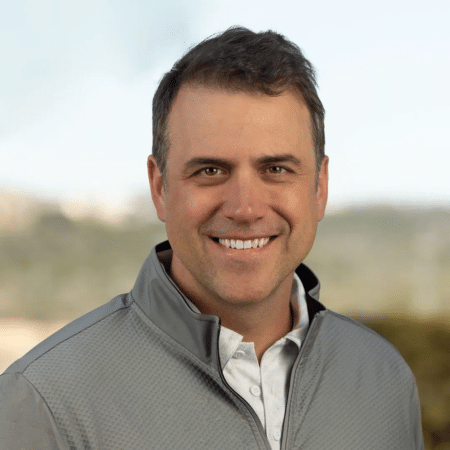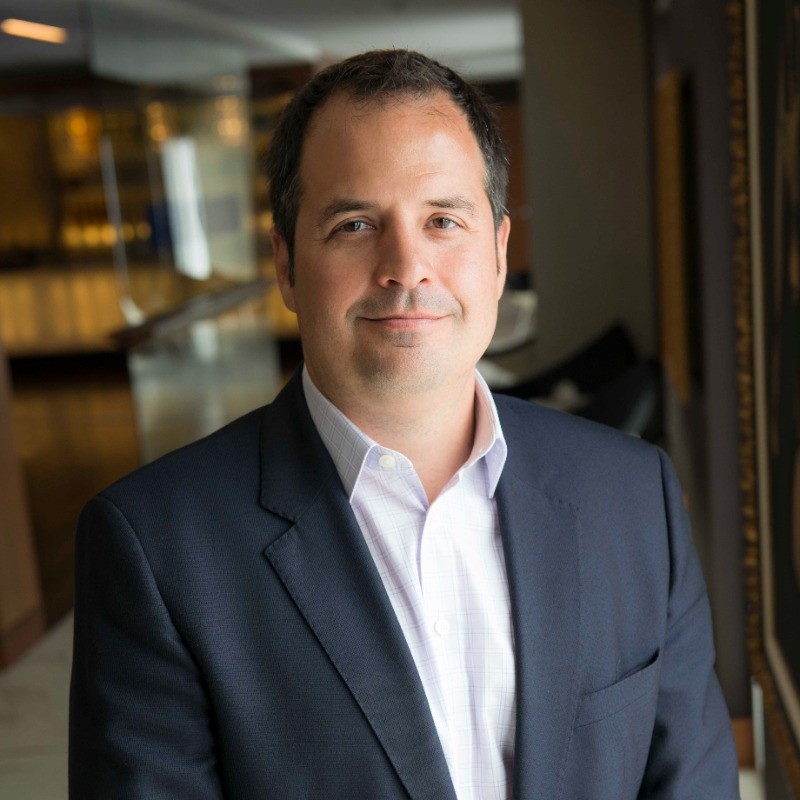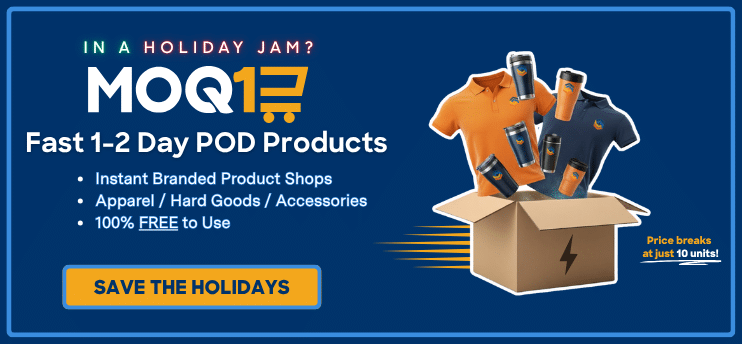I’ve never met Frank Myers.
In an industry that thrives on relationships and visibility, the CEO of S&S Activewear (PPAI 256121, Platinum) has kept a relatively low profile despite nearly two decades in pivotal roles driving the company’s astonishing growth.
Or maybe that’s just my impression going into this late-April afternoon. Until now, he is probably the most consequential industry figure I’d never interviewed or even spoken to. There wasn’t much to go on: No Instagram, no Facebook – not even a LinkedIn account. Hardly anyone I spoke to in preparation knew him well, either.

Despite leading one of the largest companies in the promotional products supply chain – and having just last year engineered the biggest acquisition the industry has ever seen – he’s not the most public leader. That makes the setting for our interview all the more striking.
We meet in Salon Rose, a huge, ornately decorated circular space atop the grand staircase of Le Château Frontenac in Quebec City. The hotel is steeped in history, and this room in particular. It once hosted Roosevelt and Churchill as they mapped Allied strategies during World War II. It serves more humbly today, despite the occasional guided tours passing by and gesturing at the two of us seated over table water while talking about branded apparel.
We are a curious sight for the tourists. But I am riveted by the scene and the subject, finally face-to-face with one of the most powerful people in this quickly evolving industry.
Getting here wasn’t simple. Two flights plus a three-hour drive brought me to the riverside city, where S&S has gathered Canadian sales leaders from both sides of its recent alphabroder acquisition to unveil the integration of operations in this country. It is worth it. My editorial team has spent years trying to make inroads with leadership at S&S. The company’s communications are tightly managed. The internal circle is kept close.
But for a moment, at least, the door has been cracked. Myers is friendly, thoughtful, composed and down-to-earth, while also fully aware of the scope of the business he and the team have built.
The Climb
Myers spoke Spanish before English, owing to his mother’s upbringing in Spain. He grew up in Minnesota, but when he left for college at Northwestern in Chicago, he never looked back. At some point during his studies, he says, a switch flipped in his mind.

Frank Myers
CEO, S&S Activewear
“It became apparent that there are two ways you could live,” he tells me. “It’s not about money. It’s more just about being fulfilled with work, you know?”
His father and grandfather had been business-oriented, and Myers took off down the same path through his studies and work ethic. First a young hotshot in investment banking, and a top analyst in his class, he later joined a private equity firm. He was only in his mid-20s when S&S hired him to run a newly acquired supplier following his evaluation of the company. He knew little of the industry, but S&S’s founding leaders saw something in Myers – sharp, operationally-minded, unencumbered – and sent him west to Los Angeles.
It was 2009. S&S had just one location in Illinois, but ambitious plans, too. Myers had no kids, little reason to say no and enough confidence to take on a job that might’ve scared others with decades more experience.
The assignment, like much of what followed, moved quickly. Within a few years, Myers stepped into a broader operational role at S&S. He would be CFO and COO. He was president by 2021, then became CEO a year later, when Jim Shannon retired.
Myers’ growth mirrored that of the company as a whole. The 2010s brought organic expansion by adding facilities and opening new markets. There were acquisitions in service of that scale, too – not headline-grabbing ones like the alphabroder deal, but meaningful plays that gave S&S enhanced reach and depth. Some helped build out underrepresented regions and new customer segments. But the thread running through it all was to create consistency – of high service systems, of data, of expectations – and replicate what was important to its customers through operational excellence, broad product selections, deep inventory and a rocking sales force.
Even before the alphabroder deal, S&S had already grown more than 17-fold since Myers joined the company. For 2024, the combined operation reports $3.6 billion in promotional products revenue, trailing only SanMar in the industry.
The recipe, as Myers describes it, was “this relentless focus on what the customer needed from a product standpoint and from a service standpoint.
“We always thought of our business as ‘we grow when our customers grow.’ Anything we can do to enable their growth, whether that’s new geographies, new products, new categories, new channels or new technology, that’s where we wanted to invest.”

Frank Myers
CEO, S&S Activewear
Along the way, Myers says, he learned something less quantifiable. From Shannon and fellow company veterans Jeff Adams and Paul Rohr, he says, he came to understand the value of relationships.
“When you’re 25, I felt like you had to win every negotiation and win every single point; it was a loss if it wasn’t a total victory,” Myers says. “There was some personal growth around reorienting for a longer-term view that you don’t have when you’re starting your career in investment banking or when you’ve been in business for three years or five years. … But it made us make the right choices, and that’s why we’re where we are now.”
Myers’ own broader view of life has brought him a family – a wife and two kids, ages 9 and 5. He admits he could still stand to be less focused on his work – he starts at 3 a.m. many days – but he’s grounded enough to manage the house by himself while his wife goes to climb Mount Kilimanjaro with friends this month. He credits much of his success to the support of his wife and their strong marriage.
It’s all made possible, evidently, by sticking to priorities and avoiding distractions like social media. Myers is still just 41, and he sees plenty more room to grow from here in the decades ahead. For he and his team at S&S, the future is more energizing and exciting than the past.
The Big Deal
For years, alphabroder was the company S&S Activewear chased. Larger, more established, better known across certain segments of the market. At points since Myers joined the business, it was five times the size of S&S. He remembers printing out its financials – then publicly available – and using them in early salary negotiations. “They were totally the Goliath,” he says.
And then last summer, S&S acquired them.
The move instantly reshaped the power structure of the apparel supply chain. Whereas previously SanMar did nearly as much business as its two largest competitors combined, the playing field leveled virtually overnight. S&S had long since outgrown its early roots, but this was different – alphabroder was a rival, not a regional player. The acquisition added not just volume and customers, but legacy systems, facilities, brands and people, many of whom had spent years competing with S&S. This wasn’t an ordinary acquisition, but one potentially transforming to an industry.
“There was a sense of accomplishment,” Myers says, “but it wasn’t like a moment where we went to [alphabroder headquarters] and spiked the football on the star.” There was too much respect for the legacy alphabroder team, their capabilities and accomplishments over the last 30 years. Too many people to align, warehouses to evaluate and systems to connect. The real work was only beginning.
Just a few weeks before the deal was announced, S&S hired Toby Whitmoyer as chief commercial officer, a newly created role overseeing all sales, marketing and product teams. A veteran of the alcoholic beverage industry, he had led integrations before. He knew the strain they put on people and process. He also saw the opportunity.
“It wasn’t a takeover,” Whitmoyer says. “In a sense, it was a combination, trying to combine the best of both companies to build a scale player. To be the leader in the space is the intention.”

Toby Whitmoyer
Chief Commercial Officer, S&S Activewear
I meet Whitmoyer in Salon Rose as well. He’s not quite a year into his role, having joined a team that was already moving fast. The ink was barely dry on the deal when work began to consolidate operations in Canada, where S&S had a foothold through its 2021 acquisition of TechnoSport. Behind the scenes, systems were already being evaluated. Distribution centers were on the whiteboard. And Prime Line – alphabroder’s hard goods division – was being positioned for a strategic relaunch.
It was clear the integration wouldn’t be a slow transition. That wasn’t S&S’s style. Canada went first. The U.S. is to follow with an integration that should announce completion any day now. There will be one website – one source, intended as a new and improved approach to the way S&S engages and supports its customers.
It isn’t the end of anything. It’s meant to be the start of something not just bigger, but better.
Integration At Speed
If there’s a defining trait of S&S Activewear’s operational culture, it’s velocity. The company doesn’t linger. It moves.
As it worked to close the alphabroder acquisition, the integration process was already well underway. The Canadian market offered a proving ground for how quickly and effectively two companies with shared history but distinct systems could become one. On April 1, less than six months after the deal closed, S&S transitioned the entire Canadian business to its proprietary ERP and warehouse management system: ApparelSoft.
That detail matters. ApparelSoft isn’t a vendor solution – it’s a system S&S built for itself, from the ground up, to handle the specific demands of the imprintable space: fast turnarounds, deep inventory, precise fulfillment. Most companies bring the software to the business. S&S shaped the software around it, the development of which was led by 17-year S&S leader and CTO Brian Beale. “Often IT and systems are the limiting factor in integrations,” Whitmoyer says. “It’s something that S&S has really got a good playbook for, and our IT group has done a phenomenal job.” S&S has an internal team that effectively operates as a software business for its bespoke technology platform.
For the 2025 PPAI 100, S&S earned High Marks in the Innovation category, measuring each company’s leadership through digital transformation. It pairs that with High Marks for Online Presence, 2024 Revenue and Growth.
With Canada converted, the focus has shifted entirely to the U.S., where the scale is significantly larger. The roadmap is aggressive.
Behind those transitions are real decisions. The combined footprint of S&S and alphabroder meant duplication – multiple distribution centers serving overlapping regions. As part of the integration, S&S has made several strategic calls. It closed its legacy facility in Pompano Beach, Florida, while keeping alphabroder’s Orlando operation, where all orders and services will transition to. It retained the alphabroder distribution center in Fresno, California, giving S&S a valuable physical presence in that state. In Massachusetts, the alphabroder warehouse stayed open, adding coverage in the Northeast. These are tactical moves meant to sharpen fulfillment and improve service consistency, bringing alphabroder to the internal S&S standard with an improved service level.
“Continuing S&S’s ability to really stand out in terms of customer service, delivery, accuracy and efficiency is absolutely the heart of the integration work,” Whitmoyer says.
For S&S, fast integration isn’t new. When the company acquired TechnoSport, it converted the business to its systems within 90 days. The transition happened before the full brunt of COVID hit – a decision Myers credits with helping the company fully retain its headcount during the most volatile period the industry has faced in decades.
What’s happening now is bigger, but the mindset hasn’t changed. “We’ve always been super-focused on the customer, which means executing and moving quickly,” Myers says.
That urgency is the foundation of the integration. It’s not just stitching systems together but getting through it fast enough to start building again.
Culture Merge
Integrations often falter where org charts can’t help – where teams, habits and assumptions collide. But in the case of S&S and alphabroder, the people fit has been one of the simpler parts of the equation, according to leadership.
“More similar than different,” is how Whitmoyer describes the two cultures. Longtime competitors, yes, but rooted in the same daily reality: large, fast-moving businesses built to serve the demands of decorators and distributors. That shared foundation made the first few months of integration more collaborative than combative. “The teams have worked really well together,” Whitmoyer says. “That’s been a huge benefit.”
After my interviews in Salon Rose, I have a few hours to kill in the historic district of Quebec City, where a day before, merged teammates bonded during a scavenger hunt along the waterfront, past the old fortification and the statues up and down Rue des Carrières. In the evening, I check back in with the team at a reception for sales leaders and vendors.
Sitting at a table with former alphabroder employees, I’m struck by how normalized their experience already seems. I’ve been on the acquired end of a merger in a past career stop and know how stressful and worrisome these can be. But no one seems troubled at all.
A scroll of LinkedIn shows people I know around the country who seem to be settling nicely. Cheron Greene, the 10-year alphabroder VP, announced her new role as S&S VP of sourcing and sustainability: “Thrilled to step into my new role … excited to bring energy and passion to the journey ahead.” There are plenty more alphabroder vets recognizing new career paths in the combined company.
Obviously, and regretfully, redundancies are created in most any merger. But this one does appear to be pretty smooth by any standard.
Consolidation is nothing new to the promo industry at this point. In fact, it appears poised to accelerate, as many large industry players near the typical private equity exit ramp. In April, No. 11 PPAI 100 supplier Koozie Group was acquired by a new private equity firm, which merged it with No. 31 supplier Garyline. More are on the way.
What’s Next
At this point, there is not another alphabroder deal for S&S to make. The company has a competitor in SanMar that likes its position. So, for S&S, the focus will again be on organic growth. Pair that with international expansion, the development of new channels and driving growth in categories that have historically been underrepresented in the promo industry, like workwear.
One of the earliest post-merger decisions S&S made was to separate Prime Line – the hard goods division historically housed within alphabroder – into a standalone business unit with its own ops structure. Industry vet Eric Leven was named general manager.
“It needs to scale,” Myers says. “We’ve invested in a dedicated sales force. We’ve invested in a new website. We’re investing in some really exciting product stuff. Our intent is to go and take a bunch of market share there. We like the market. It’s a big market. It’s a growing market. I think we can service it in a way that’s superior to others, and we need to – and will – grow it quickly.
“With all this tariff stuff going on, there’s opportunity. There are people who are facing pretty serious challenges, and we’re well resourced, well capitalized and committed to the channel. That’s the spot where M&A can be interesting.”
S&S is owned by private equity firm Clayton, Dubilier & Rice. Behind any deals S&S or its sponsor may do from here, the strategy will be toward technology as an enabler. Nowhere is innovation more visible than inside S&S’s distribution centers. The company has committed over $200 million in capital expenditures to automate nearly all of its facilities using PopPick, the robotic fulfillment platform. Robots pick and bring the product to workers, who stay in place and prepare it for shipment.
The result? “We’ve found that our employees are happier, more engaged, and our safety has improved,” Whitmoyer says.
And, of course, robots improve order accuracy and create efficiency that delivers on the bottom line, which is meaningful to stakeholders. Companies at this sort of size are investments, not passion projects. Greater margins mean reinvestment and theoretically even greater revenues, margins and valuations. Pricing has, of course, been a consideration, too. Whitmoyer says the success of the merger isn’t contingent on higher prices.
Out In Front
During our interview, I tell Myers that, at least for this year, S&S will not rank as the PPAI 100 No. 1 supplier. SanMar maintains the lead, largely on the strength of its estimated $600 million revenue edge.
He’s not at all bothered. And later, at the reception, he tells me that he hopes he made it clear that industry leadership is truly the goal, not just multiplied sales.
“Honestly, I don’t wake up every day like, ‘I want to be No. 1 as measured by revenue,’” Myers says. “We want to do and provide something different. And if that means we are No. 2 in the revenue of the industry, then so be it. But I know we’ll be No. 1 in the industry if we are No. 1 in the hearts of our customers.”
Fitting of the strategy that has helped S&S rise to its current status, he hopes the merged company – under whatever brand is decided – can enable customers themselves to grow the industry pie.
When Myers first went to work at S&S in 2009, the company still took orders by fax machine. To him, that change is emblematic of the evolution S&S has tried – and will continue to try – to encourage.
“When I say I view us as the industry leader, I don’t mean it necessarily in size,” Myers says. “I mean in terms of pushing the envelope of what the industry is. We all need this market to grow. We need to help.”


